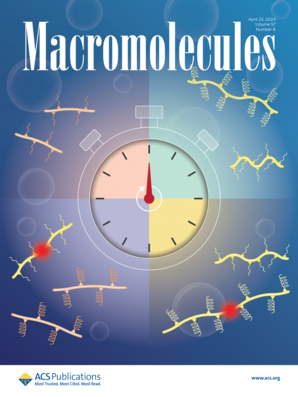磁性可分离共轭微孔三苯基膦网络实现双门控光诱导原子转移自由基聚合反应
IF 5.1
1区 化学
Q1 POLYMER SCIENCE
引用次数: 0
摘要
磁刺激在控制精度、穿透性、稳定性和生物相容性方面具有卓越的优势,超越了其他刺激方式,使其成为远程、非接触、长时间和多功能应用的理想候选者。通过实施战略性的分子工程方法,可以开发出响应各种外部刺激的先进光催化平台,而不仅仅是光。在这项研究中,我们报道了使用Fe3O4@PP-E核壳纳米复合材料设计磁/光双门光诱导原子转移自由基聚合(photoatrp)体系。以三苯基膦为光催化组分,2,4,6-三(4-乙基苯基)-1,3,5-三嗪为连接剂,在磁铁矿(Fe3O4)胶体纳米晶团簇上通过sonogashhara - hagihara交叉偶联反应制备了纳米复合材料。本研究包括优化聚合条件以控制分子量和实现快速反应动力学,同时也证明了光催化剂通过磁吸引的可回收性。此外,还演示了双门控光- atrp,通过打开/关闭灯和将磁铁放入/取出。该系统还用于在生物相关条件下合成定义明确的蛋白质-聚合物偶联物,并保留其生物活性。这种方法通过加强催化剂去除过程和促进可持续性,有助于聚合物制造的进步。本文章由计算机程序翻译,如有差异,请以英文原文为准。

Magnetically Separable Conjugated Microporous Triphenylphosphine Networks Enabling Dual-Gated Photoinduced Atom Transfer Radical Polymerization
Magnetic stimulation demonstrates exceptional advantages in control precision, penetrability, stability, and biocompatibility, surpassing other stimulus modalities, which positions it as an ideal candidate for remote, noncontact, long-duration, and multifunctional applications. By implementing strategic molecular engineering approaches, advanced photocatalytic platforms responsive to a variety of external stimuli, beyond just light, can be developed. In this study, we report the design of a magnetism/light dual-gated photoinduced atom transfer radical polymerization (photo-ATRP) system using Fe3O4@PP-E core–shell nanocomposites. The nanocomposites were fabricated by incorporating triphenylphosphine as the photocatalytic component and 2,4,6-tris(4-ethynylphenyl)-1,3,5-triazine as the linker via a Sonogashira–Hagihara cross-coupling reaction on magnetite (Fe3O4) colloidal nanocrystal clusters. This study included the optimization of polymerization conditions to control molecular weights and achieve fast reaction kinetics while also demonstrating the recyclability of the photocatalyst through magnetic attraction. Moreover, dual-gated photo-ATRP was demonstrated by switching the light on/off and applying the magnet in/out. This system was also applied to synthesize well-defined protein–polymer conjugates under biologically relevant conditions, preserving their biological activity. This approach contributes to advancements in polymer manufacturing by enhancing catalyst removal processes and promoting sustainability.
求助全文
通过发布文献求助,成功后即可免费获取论文全文。
去求助
来源期刊

Macromolecules
工程技术-高分子科学
CiteScore
9.30
自引率
16.40%
发文量
942
审稿时长
2 months
期刊介绍:
Macromolecules publishes original, fundamental, and impactful research on all aspects of polymer science. Topics of interest include synthesis (e.g., controlled polymerizations, polymerization catalysis, post polymerization modification, new monomer structures and polymer architectures, and polymerization mechanisms/kinetics analysis); phase behavior, thermodynamics, dynamic, and ordering/disordering phenomena (e.g., self-assembly, gelation, crystallization, solution/melt/solid-state characteristics); structure and properties (e.g., mechanical and rheological properties, surface/interfacial characteristics, electronic and transport properties); new state of the art characterization (e.g., spectroscopy, scattering, microscopy, rheology), simulation (e.g., Monte Carlo, molecular dynamics, multi-scale/coarse-grained modeling), and theoretical methods. Renewable/sustainable polymers, polymer networks, responsive polymers, electro-, magneto- and opto-active macromolecules, inorganic polymers, charge-transporting polymers (ion-containing, semiconducting, and conducting), nanostructured polymers, and polymer composites are also of interest. Typical papers published in Macromolecules showcase important and innovative concepts, experimental methods/observations, and theoretical/computational approaches that demonstrate a fundamental advance in the understanding of polymers.
 求助内容:
求助内容: 应助结果提醒方式:
应助结果提醒方式:


